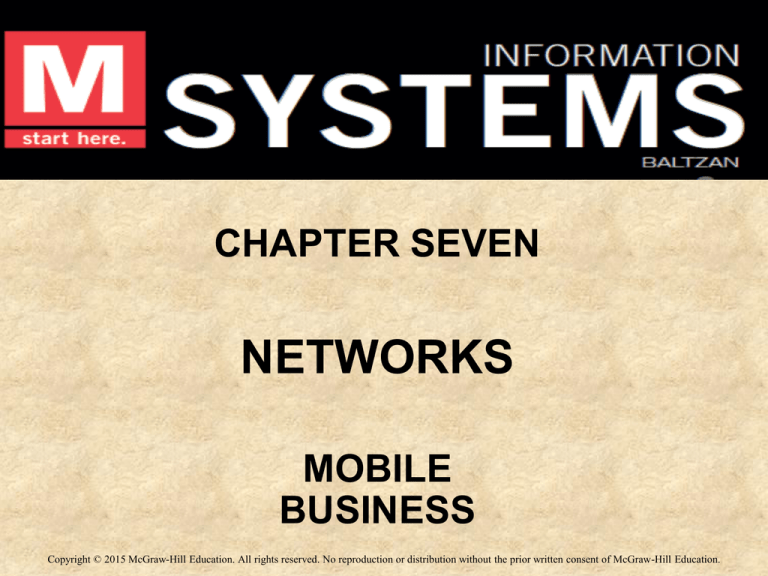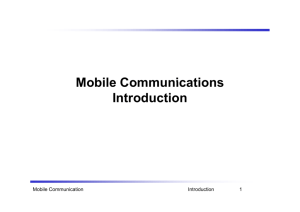
CHAPTER SEVEN
NETWORKS
MOBILE
BUSINESS
Copyright © 2015 McGraw-Hill Education. All rights reserved. No reproduction or distribution without the prior written consent of McGraw-Hill Education.
CHAPTER OVERVIEW
SECTION 7.1 – Connectivity: The Business
Value of a Networked World
• Overview of a Connected World
• Benefits of a Connected World
• Challenges of a Connected World
SECTION 7.2 – Mobility: The Business Value
of a Wireless World
•
•
•
•
Wireless Network Categories
Business Applications of Wireless Networks
Benefits of Business Mobility
Challenges of Business Mobility
7-2
SECTION 7.1
CONNECTIVITY
7-3
LEARNING OUTCOMES
1. Explain the five different networking elements
creating a connected world.
2. Identify the benefits and challenges of a
connected world
7-4
OVERVIEW OF A CONNECTED
WORLD
Networking Elements Creating a Connected World
7-5
Network Categories
Local area network (LAN) Connects a group of computers in
close proximity, such as in an office
building, school, or home
Wide area network (WAN) - Spans a
large geographic area such as a state,
province, or country
Metropolitan area network (MAN) A large computer network usually
spanning a city
7-6
Network Providers
National service providers (NSPs) - Private
companies that own and maintain the worldwide
backbone that supports the Internet
Network access points (NAPs) - Traffic
exchange points in the routing hierarchy of the
Internet that connects NSPs
Regional service providers (RSPs) - Offer
Internet service by connecting to NSPs, but they
also can connect directly to each other
7-7
Network Access Technologies
Bandwidth - The maximum amount
of data that can pass from one point
to another in a unit of time
• Bit
• Bit rate
• Modem
7-8
Network Access Technologies
Broadband – A high-speed Internet
connection that is always connected
• Digital subscriber line
• Internet cable connection
• High speed Internet cable connections
• Cable modem
• Telecommuting
• Broadband over power line
7-9
Network Protocols
Protocol - A standard that specifies
the format of data as well as the rules
to be followed during transmission
Transmission control
protocol/Internet protocol (TCP/IP) Provides the technical foundation for
the public Internet as well as for large
numbers of private networks
Domain name system – Converts
IP addresses into domains
7-10
Network Protocols
Packet
Standard packet format
Packet header
Packet footer
Traceroute
Proxy
7-11
Network Protocols
Example of TCP/IP
7-12
Network Protocols
Internet Domains
7-13
Network Convergence
Network convergence - The efficient
coexistence of telephone, video, and data
communication within a single network, offering
convenience and flexibility not possible with
separate infrastructures
7-14
Network Convergence
Unified communication (UC) - The integration of
communication channels into a single service
Peer-to-peer (P2P) – A computer network that
relies on the computing power and bandwidth of
the participants in the network rather than a
centralized server
7-15
Network Convergence
Voice over IP (VoIP) - Uses IP technology to
transmit telephone calls
Internet Protocol TV (IPTV) - Distributes digital
video content using IP across the Internet and
private IP networks
7-16
BENEFITS OF A CONNECTED
WORLD
Networks offer many advantages for a
business including
• Sharing resources
• Providing opportunities
• Reducing travel
7-17
Sharing Resources
The primary resources for sharing include
• Intranet
• Extranet
• Virtual private network
7-18
CHALLENGES OF A
CONNECTED WORLD
Networks create a diverse globally
connected world eliminating time and
distance
Networks make it possible to
communicate in ways not previously
imaginable
Even though networks provide many
business advantages, they also create
increased challenges in security,
social, ethical, and political issues
7-19
Security
SSL Certificate - An electronic
document that confirms the identity of
a website or server and verifies that a
public key belongs to a trustworthy
individual or company
Secure hypertext transfer protocol
(SHTTP or HTTPS) - A combination
of HTTP and SSL to provide
encryption and secure identification of
an Internet server
7-20
Social, Ethical, and Political Issues
Digital divide - A worldwide gap giving
advantage to those with access to technology
7-21
SECTION 7.2
Mobility
7-22
LEARNING OUTCOMES
3. Explain the different wireless network
categories
4. Explain the different wireless network business
applications
5. Identify the benefits and challenges of
business mobility
7-23
WIRELESS NETWORK
CATEGORIES
7-24
Personal Area Network
Personal area networks (PAN)
- Provide communication over a
short distance that is intended for
use with devices that are owned
and operated by a single user
Bluetooth - Wireless PAN
technology that transmits signals
over short distances between cell
phones, computers, and other
devices
7-25
Wireless LAN
Wireless LAN (WLAN) - A local area network that uses
radio signals to transmit and receive data over distances
of a few hundred feet
Wireless fidelity (Wi-Fi) - A means by which portable
devices can connect wirelessly to a local area network,
using access points that send and receive data via radio
waves
7-26
Wireless LAN
Access point – The computer or network device that
serves an as interface between devices and the network
Wireless access point – Enables devices to connect to
a wireless network to communicate with each other
Multiple-in/multiple-out technology – Multiple
transmitters and receivers allowing them to send and
receive greater amounts of data than traditional
networking devices
7-27
Wireless MAN
Wireless MAN (WMAN) - A metropolitan
area network that uses radio signals to
transmit and receive data
7-28
Wireless MAN
Worldwide
Interoperability for
Microwave Access
(WiMAX) - A
communications
technology aimed at
providing high-speed
wireless data over
metropolitan area
networks
7-29
Wireless WAN - Cellular
Wireless WAN (WWAN) - A wide area network
that uses radio signals to transmit and receive
data
7-30
Wireless WAN - Cellular
Smart phone - Offer more advanced computing
ability and connectivity than basic cell phones
3G - A service that brings wireless broadband to
mobile phones
Streaming – A method of sending audio and
video files over the Internet
7-31
Wireless WAN - Satellite
Satellite - A space station that orbits the Earth
receiving and transmitting signals from Earthbased stations over a wide area
7-32
BUSINESS APPLICATIONS OF
WIRELESS NETWORKS
Areas experiencing tremendous growth using
wireless technologies include
7-33
Radio Frequency
Identification (RFID)
Radio frequency identification (RFID) - Uses
electronic tags and labels to identify objects
wirelessly over short distances
7-34
Radio Frequency
Identification (RFID)
RFID tag - An electronic identification device that is
made up of a chip and antenna
RFID reader (RFID interrogator) - A
transmitter/receiver that reads the contents of RFID
tags in the area
Passive RFID tag - Does not have a power source
Active RFID tag - Contains a transmitter and a
power source (typically a battery)
7-35
Radio Frequency
Identification (RFID)
Semipassive RFID tag - Uses a battery to run the microchip’s
circuitry, but communicate by drawing power from the RFID reader
Asset tracking - Occurs when a company places active or semipassive RFID tags on expensive products or assets to gather data on
the items’ location with little or no manual intervention
RFID accelerometer - A device that measures the acceleration (the
rate of change of velocity) of an item and is used to track truck
speeds or taxi cab speeds
Chipless RFID tag - Uses plastic or conductive polymers instead of
silicon-based microchips, allowing them to be washed or exposed to
water without damaging the chip
7-36
Global Positioning System
Global positioning system (GPS) - A satellitebased navigation system providing extremely
accurate position, time, and speed information
Automatic vehicle location (AVL) – Uses GPS
tracking to track vehicles
Latitude - Represents a north/south
measurement of position
Longitude - Represents an east/west
measurement of position
7-37
Global Positioning System
Geocache - A GPS technology adventure game that
posts the longitude and latitude location for an item on
the Internet for users to find
Geocoin - A round coin-sized object uniquely numbered
and hidden in geocache
Estimated time of arrival (ETA) - The time of day of an
expected arrival at a certain destination and is typically
used for navigation applications
Estimated time enroute (ETE) - The time remaining
before reaching a destination using the present speed
and is typically used for navigation applications
7-38
Geographic Information
Systems (GIS)
Geographic information system
(GIS) - Consists of hardware,
software, and data that provide location
information for display on a
multidimensional map
7-39
Geographic Information
Systems (GIS)
Cartography - The science and art of making
an illustrated map or chart
Edge matching (warping, rubber sheeting) Occurs when paper maps are laid edge to edge
and items that run across maps but do not
match are reconfigured to match
GIS map automation - Links business assets
to a centralized system where they can be
tracked and monitored over time
7-40
Geographic Information
Systems (GIS)
Spatial data (geospatial data or
geographic information) - Identifies the
geographic location of features and
boundaries on Earth, such as natural or
constructed features, oceans, and more
Geocoding - A spatial databases coding
process that assigns a digital map feature an
attribute that serves as a unique ID or
classification
7-41
Geographic Information
Systems (GIS)
Location based services (LBS) - Applications that
use location information to provide a service
7-42
BENEFITS OF BUSINESS
MOBILITY
7-43
BENEFITS OF BUSINESS
MOBILITY
Enhance mobility
Provides immediate data access
Increases location and monitoring
capability
Improves work flow
Provides mobile business opportunities
Provides alternative to wiring
7-44
CHALLENGES OF BUSINESS
MOBILITY
7-45
CHALLENGES OF BUSINESS
MOBILITY
Protecting against theft
Protecting wireless connections
Preventing viruses on a mobile
device
Addressing privacy concerns with
RFID and LBS
7-46
CHALLENGES OF BUSINESS
MOBILITY
Wired equivalent privacy (WEP) - An encryption
algorithm designed to protect wireless transmission
data
War chalking - The practice of tagging pavement with
codes displaying where Wi-Fi access is available
War driving - Deliberately searching for Wi-Fi signals
while driving by in a vehicle
7-47
LEARNING OUTCOME REVIEW
Now that you have finished the chapter
please review the learning outcomes in
your text
7-48









